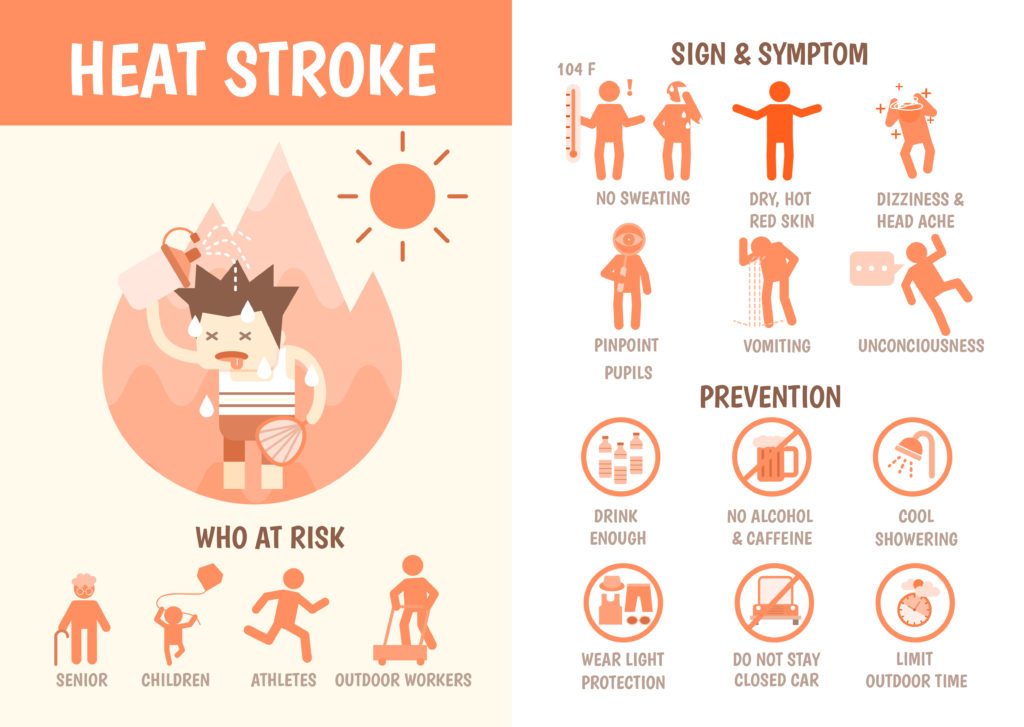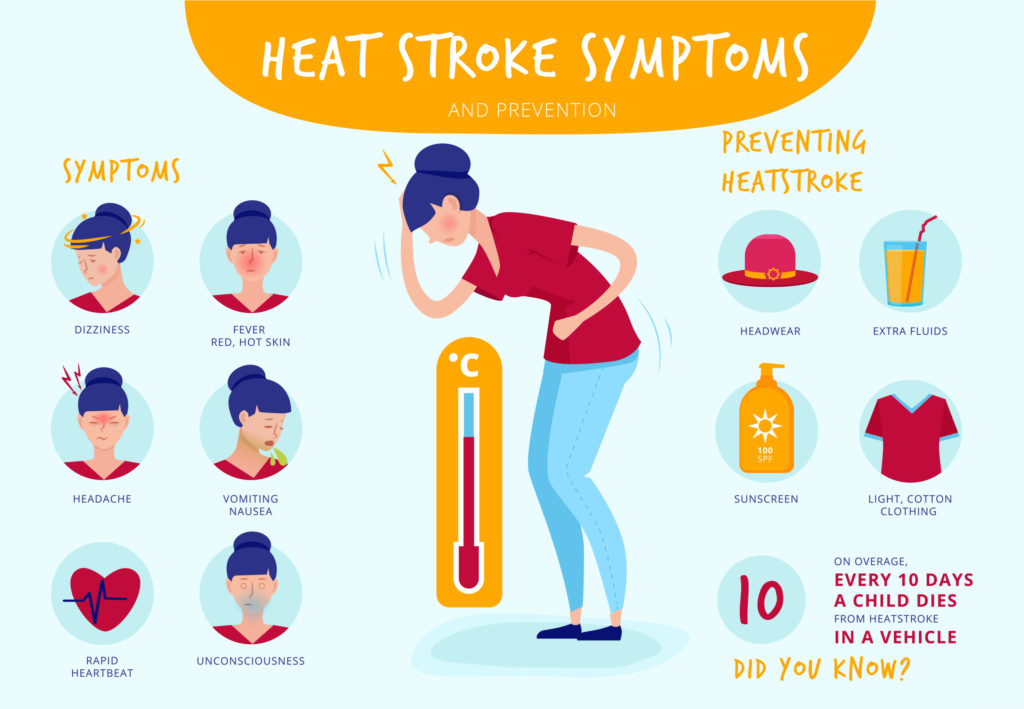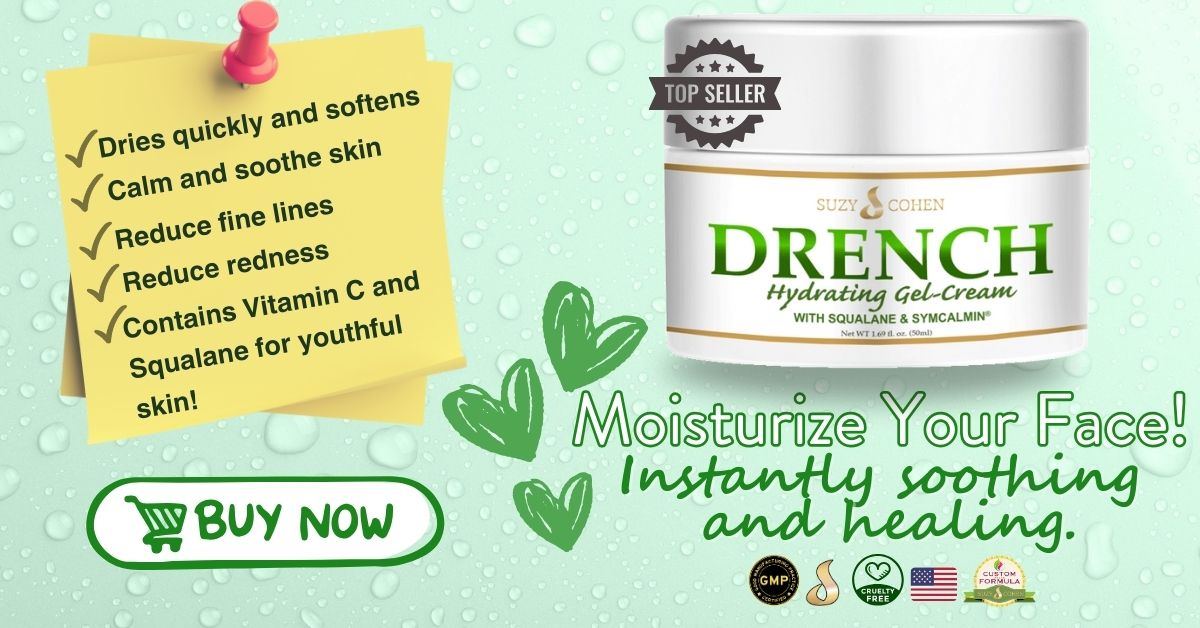What's On This Page?
ToggleI consider myself heat-intolerant. I hate the heat. I remember suddenly feeling like I wanted to pass out during travel to Florida (from Colorado), and by the time I got out of the airport, and to my rental car in the parking garage I was weak. Then I started driving, for a split second I felt like could pass out but it quickly stopped once I put the AC (air conditioner) on high and drank my water bottle.
I went from something like 65 degrees that morning in Colorado, to 103˚ because Florida was in a heat wave, and the steamy rental car was even hotter! My body was screaming “No!” so I’d conclude that one less talked about risk factor is an extreme change in temperature. Going from cool to sweltering heat doesn’t give your body proper time to adjust. It didn’t help that I’d had a double shot espresso on the plane. Caffeine is problematic when it comes to thermoregulation.
Your Body has a Normal Thermostat
Our body’s normal temperature is about 98.6˚ degrees F (37˚ C). Your body generates its own warmth, so when combined with hot outdoor temperatures, it raises your core, internal temperature.
Your body then automatically sweats in an involuntary process intended to protect you, and cool you off. There’s a balance so if you don’t sweat that much, due to hypothyroidism or anhidrosis, and you simultaneously expose yourself to the hot sun, or exercise strenuously, then you could have trouble. I recall a hot yoga class once, where I overdid it, and the temperature was obscenely high, and I had to step out of class to just breathe for 5 minutes!
It may seem like it can’t happen to you, and hopefully it won’t. But I must tell you that in 2019, 1.7 million people died accidentally from the heat! There’s an article you can read HERE that outlines the details from two relatively new studies about extreme hotness!
The point is, if you can’t cool off in time, you will get a heat-related illness. Today, I will outline them all and help you know what to do in case your body develops problems from the summer heat. Knowing the difference between these problems is important.

The Causes of Heat Cramps, Heat Stroke and Exhaustion: Why does it happen to some and not others?
There are many reasons one person -and not another- will experience problems from thermal dysregulation, or the most difficult illness called heat stroke. Say you’re on a hike with a friend up Chautauqua Mountain in Boulder, Colorado.
And say it’s like 85 degrees that day. And don’t forget you’re starting a mile high because of Colorado’s natural elevation! I’ve done this very hike with my friend Melissa and we were both fine. But in this story, why might one person on that trip feel bad, and another person feel good. Lots of things come into play.
Weight comes into play. So does your body’s level of hydration. For example, dehydration will reduce your body’s total fluid volume, which then reduces your ability to sweat, which then leads to higher core temperatures. The higher your body’s core temperature, the harder it is to overcome hotter temperatures from the environment, like being in direct sun, or in a hot jacuzzi, or even inside your house without working air conditioning.
Drinking alcohol matters. If you drink a vodka cranberry before the trip, it increases your risk. If you are out fishing on the lake, and you’ve had several beers, risk is higher. This is because alcohol causes your body has lost some ability to properly thermoregulate. The more alcohol, the higher the risk.
What about drinking coffee? Yes, it can raise risk for heat-related illness even though it gives you a nice caffeine push. So if you’ve enjoyed a double shot espresso and then go hiking, you’re dehydrated, and that’s not good.
Clothing matters too. If you are wearing fabrics that don’t allow your sweat to evaporate easily, it will increase risk.
People over 65 years of age, and infants are affected most, and have the highest risk for heat-related illness. People who are generally heat intolerant, or have heart disease may also be at risk. If you have LVH (Left Ventricular Hypertrophy) or another type of cardiomyopathy (even related to statin-induced CoQ10 depletion), your sensitivity to hotter temperatures increases. There’s a PAPER here that discusses the relationship, Relation Between Temperature Extremes And Symptom Exacerbation In Patients With Hypertrophic Cardiomyopathy.
Finally, certain medications that you take can raise your risk. These are not all the factors, just the main ones. Remember, anyone can develop heat exhaustion, but certain factors increase your sensitivity to heat. Now, let’s briefly look at the 3 most common types of heat-related illness.
1. HEAT CRAMPS
This is the mildest type of problem and is pretty easy to recover from with a few quick interventions. The spasms and cramps obviously hurt, they happen involuntary and can occur all over, like in your arms, shoulders, calves or even your abdomen. They maybe brief and intermittent but nevertheless, very painful. The change in fluid and electrolyte balance causes the cramp, this is why sports drinks work so well. If you’re at home and you don’t have an electrolyte drink, you can make one by mixing 1/2 teaspoon sea salt into a quart of water and if you have some juice (any flavor) add 1/4 cup to the drink. Sip it slowly.
Symptoms of Heat Cramps
- Sweating
- Fatigue
- Thirst
- Muscle cramps
- Feeling weak
Here are Potential Treatment
Mild cramps are pretty common.They’re also sometimes self-limiting if they’re really mild. If you think you have this, just lay down and cool off and remove some clothing if you have layers on. Sip cold water and sponge off or fan yourself.
1. Drink cool water or a sports drink with electrolytes. Don’t be ‘afraid’ of the high sodium content on these drinks (like Powerade, Gatorade, etc). That’s okay in this situation because you’re trying to mimic sweat in a way, and sweat naturally contains high amounts of sodium. That said, salt tablets are not indicated, and should not be used.
2. Move away into the shade, or an air-conditioned space
3. Rest, do not continue your activity —> let your body’s thermoregulation system kick in, it knows what to do once you are more settled
4. If symptoms persist, get help.
2. HEAT EXHAUSTION
Heat exhaustion is the next phase of heat-related illness after heat cramps. But these will accompany the illness, so be aware that the symptoms are similar, but they are worse! See below for a list of specific symptoms.
Symptoms of Heat Exhaustion
- Muscle cramps
- Clammy cold skin (with goose bumps when in the heat)
- Syncope (faintness)
- Profuse sweating
- Dizziness
- Fatigue
- Weak, rapid pulse
- Low blood pressure upon standing
- Nausea and vomiting (which may require you to get to an ER for IV saline hydration)
- Headache
- Shortness of breath
Get help and contact a physician or urgent care center if your symptoms do not abate, or if they worsen and you can’t drink anything, or you start to experience confusion, agitation, or a loss of consciousness. If a thermometer is handy, and you’re above closer to or above 104, you’ll need to seek an ER for immediate medical attention. The reason is because permanent damage may occur to your brain and vital organs, and it can result in death.
Medications that Raise Risk for Heat-Related Illness
Certain medications negatively impact your body’s ability to stay properly hydrated, or to physiologically respond to hot temperatures. These include some very popular meds, here is a list of some of them. But I’m not telling you to stop or pause these, I’m just educating you about them so you know in advance that your risk is higher.
Antihistamines can be a problem
These types of drugs include Benadryl® and Claritin® which go by generic names diphenhydramine and loratadine, respectively. There are many others. Antihistamines are also called allergy pills. They dry you up, right? That means they make you more prone to dehydration. They have drying “anticholinergic” side effects. I wrote a great article entitled, How Medications Inadvertently Cause Memory Problems.
Amphetamines increase risk for these problems
Stimulant medications are prescribed for ADHD or Attention Deficit Hyperactivity Disorder. When you think of stimulants, hink of Ritalin® and clan, these drugs are stimulants and therefore they heat you up, they increase metabolic rate.
Antipsychotics increase the possibility for heat-related illness
These psychoactive drugs impact your risk for heat-related illness for several reasons. In part, it’s because they have anticholinergic (drying) side effects so they are drying in nature. They can also slow down respiration and other CNS (Central Nervous System) functions.
Benzodiazepines increase risk even if you take them at night
The category of sleeping pills known as benzodiazepines or “benzos” for short are also known as “tranquilizers” or “anxiolytics.” These drugs increase risk for both heat stroke and cramps for many different reasons. For one, the anticholinergic (drying) properties of these drugs come into play. Furthermore, they slow down heartbeat and respiration because they are CNS depressants.
How Beta Blockers alter risk
Beta blockers are used to lower blood pressure. They affect the vascular system in your body and your heart rhythm. These drugs can slow down the way your heart beats, even when you are stressed. But because they impact your heart rate, they increase your risk for heat cramps and heat stroke.
Caffeine will induce more heat cramps
Caffeine is found in medications as well as many beverages for energy. This is a well-known stimulant and heats your internal core temperature! As such, it will increase your body’s thermostat, and make it harder for you to cool off if you need to.
Cough & Cold Medicine impact your thermostat
Cough and cold medications are sold globally and have been top sellers due to the pandemic of course. But because they often contain an antihistamine, they are drying in nature, they can increase one’s risk for heat-related illness. Just be aware, there is no need to stop them, just know what the effects are if you’re taking them.
Diuretics can increase dehydration and raise risk for heat cramps
Diuretics are very popular because they work as anti-hypertensives. This means they work to lower your blood pressure and utilize kidney function to do this. That is why they are also known as water pills. It’s because they make you urinate more water from your kidneys. Because of this, they can cause dehydration from the fluid loss. If you’re already dehydrated from the heat, this is an additive problem that will exacerbate your issues and increase risk for heat cramps.
Thyroid pills can increase heat exhaustion.
Levothyroxine – thyroid medications raise internal core temperature. They’re supposed to do that, because in hypothyroidism, you may feel cold all the time. But if you’re body is running hot to begin with, then you hike up a mountain (strenuous exercise), AND it’s hot outside… Hey, if you’re interested in the thyroid connection to muscle cramps, read this article: The Statin and Thyroid Connection.

What can you do to avoid heat cramps, exhaustion and stroke
The following tips can help you avoid a serious problem. Wear proper lightweight clothing and stay hydrated. Avoid long periods of time in the sun and heat. Never leave anyone in a parked car either, I shouldn’t have to even say this, but you’d be surprised. Heat-related deaths in the car are not as uncommon as you might think! Children, frail elderly and even pets succumb to high temperatures in just a few minutes.
Avoid doing work in the hottest part of the day, and also, don’t assume your body will cool itself off just like it did when you are younger.
3. HEAT STROKE
This is a very serious and dangerous condition which I should not elaborate on because it requires medical attention. An electrolyte drink and fanning will do nothing! It’s a medical emergency.
The drug of choice used in hospitals is Dobutamine (Dobutrex®) which is structurally similar to dopamine, a catecholamine often referred to as a happy brain chemical. The drug will quickly raise blood pressure (a goal) and is injected… It treats the hypotension associated with heat stroke. You can read more about this medication at WebMD.
Pills used to increase blood pressure will also be employed for a patient suffering with heat stroke, but it depends on how low your blood pressure is when you get to the ER (emergency room).
They also use benzodiazepines because these offer immediate sedation and that can reduce shivering and convulsions if present. Sometimes phenobarbital is used alternatively in patients who cannot tolerate benzo’s. You may be interested in this article: Benzodiazepine Dangers and Lies.
Since muscles are impacted, and rhabdomyolysis may occur, other infusions, and medications are used to control that before all the muscles break down. Just FYI, ubiquinol and CoQ10 depletion may lead to rhabdomyolysis.
Physicians know exactly what to do because heat stroke is very common. Please take a moment to read my other article, Ubiquinol Eases Leg Cramps and Fuels Your Heart.
How can you differentiate between a heat stroke and heat exhaustion and stroke?
The differences are profound, but they start out the same. Heat exhaustion begins with weakness and sudden sweating and a feeling of faintness. A heat stroke might render one unconscious! It has very serious symptoms and often includes problems speaking, thinking and talking.
Heatstroke is far more deleterious than plain heat cramps or exhaustion. It can cause shock and shut down the body, making it potentially fatal. If you are a caregiver, or a spouse, please be aware of these symptoms and do not let stubborn people go out and mow their lawns in the heat, or paint the house, or whatever else they can think of… wait for cooler weather, hire out for the job, or ask a neighbor for assistance. If you think this article can help someone else, please forward. For more information, and some first aid tips, read this article on Heat Stress and Heat Related Illness.

Suzy Cohen, has been a licensed pharmacist for over 30 years and believes the best approach to chronic illness is a combination of natural medicine and conventional. She founded her own dietary supplement company specializing in custom-formulas, some of which have patents. With a special focus on functional medicine, thyroid health and drug nutrient depletion, Suzy is the author of several related books including Thyroid Healthy, Drug Muggers, Diabetes Without Drugs, and a nationally syndicated column.


